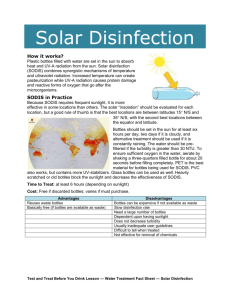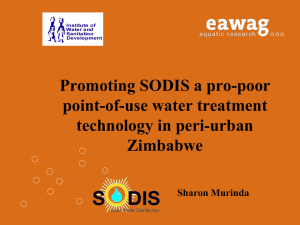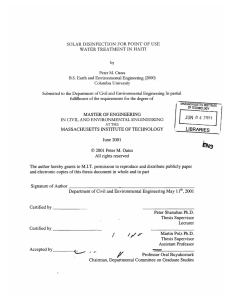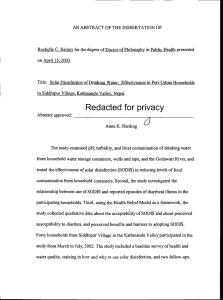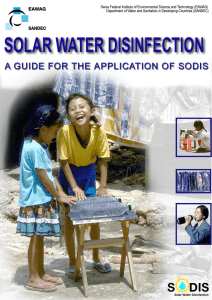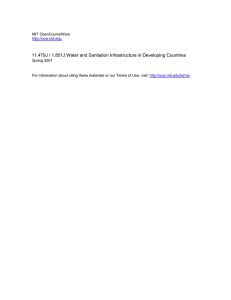Water & Development Initiatives: Safe Drinking Water Access
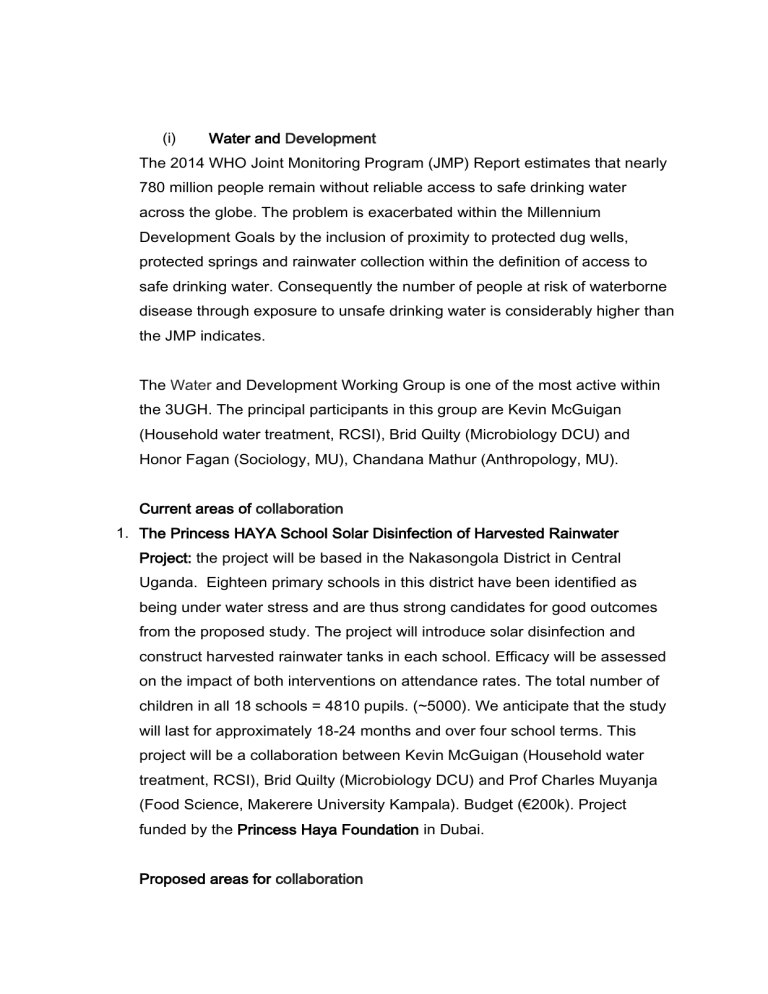
(i) Water and Development
The 2014 WHO Joint Monitoring Program (JMP) Report estimates that nearly
780 million people remain without reliable access to safe drinking water across the globe. The problem is exacerbated within the Millennium
Development Goals by the inclusion of proximity to protected dug wells, protected springs and rainwater collection within the definition of access to safe drinking water. Consequently the number of people at risk of waterborne disease through exposure to unsafe drinking water is considerably higher than the JMP indicates.
The Water and Development Working Group is one of the most active within the 3UGH. The principal participants in this group are Kevin McGuigan
(Household water treatment, RCSI), Brid Quilty (Microbiology DCU) and
Honor Fagan (Sociology, MU), Chandana Mathur (Anthropology, MU).
Current areas of collaboration
1.
The Princess HAYA School Solar Disinfection of Harvested Rainwater
Project: the project will be based in the Nakasongola District in Central
Uganda. Eighteen primary schools in this district have been identified as being under water stress and are thus strong candidates for good outcomes from the proposed study. The project will introduce solar disinfection and construct harvested rainwater tanks in each school. Efficacy will be assessed on the impact of both interventions on attendance rates. The total number of children in all 18 schools = 4810 pupils. (~5000). We anticipate that the study will last for approximately 18-24 months and over four school terms. This project will be a collaboration between Kevin McGuigan (Household water treatment, RCSI), Brid Quilty (Microbiology DCU) and Prof Charles Muyanja
(Food Science, Makerere University Kampala). Budget (€200k). Project funded by the Princess Haya Foundation in Dubai.
Proposed areas for collaboration
1.
WATERSPOUTT: Water: Sustainable Point-of-Use Treatment Technologies
(EU Horizon 2020 Call WATER-5c-2015). Coordinator: Prof Kevin
McGuigan, RCSI, Dublin, Ireland. Budget: €3.7M (EU Contribution €3.0M).
Objective :
Technological : Designing, developing and piloting new integrated solar technologies for point-of-use drinking water treatment for rural communities without access to safe drinking water throughout the world. These technology interventions will build on our previous work (EU FP6 SODISWATER) and new research. We will design, pilot, assess the performance and standardize products in accordance with international guidelines. Technological solutions will include:
(i) Solar water disinfection (SODIS) Transparent Jerry-Cans (Ethiopia)
(ii) Solar –Ceramic Filtration reactors (Malawi)
(iii) Solar reactors for rainwater harvesting + Enhanced SODIS Reactors
(Uganda, South Africa)
Technology interventions will be scalable for household (2 L to 20 L) and community (primary school, community health clinic, etc.)
Social Science: Water collection, storage and treatment is a task that is almost universally delegated to female members of households in the developing world. These tasks often necessitate that the female travel unaccompanied long distances on foot and wait for long periods at the water source. In such cases females are at increased risk of injury, sexual assault and physical abuse. Vulnerable communities without access to safe drinking water require more than just technological evidence of disinfection efficiency.
Uptake and up-scaling of solar based technologies requires innovative strategies to drive behaviour change and adoption of new interventions. If the solar based technologies are to be successfully adopted, then the dissemination strategies must be tailored such that the advantages of collection and treatment at the household are immediately apparent to those who stand to benefit most from their introduction.
2.
CERAMSODIS. Solar Facilities European Research Area. FP7. Proposed
Budget €40k. Collaboration between Kevin McGuigan (Household water treatment, RCSI), Brid Quilty (Microbiology DCU) and Plataforma Solar de
Almeria, Spain. The aim of this project is to enhance SODIS efficacy by combining SODIS with Ceramic Filtration. Recently a new design of ceramic filtration incorporating a 20L transparent reservoir for the untreated water, has been distributed in Malawi. Given the unprecedented success that the RCSI group encountered with their 2013 SFERA SODIS-LVC project which evaluated SODIS efficacy of 20L water dispenser containers [2] these socalled SAFI T9 Filters (see accompanying photo) are likely to be similarly amenable to solar disinfection. The purpose of this SFERA application is to evaluate and compare SODIS, Ceramic Filtration (CF) and Combined SODIS
+ Ceramic Filtration (CERAMSODIS). CF has been known to produce a log unit reduction value (LRV) in bacterial population of value of approx. 3.0-4.0
(99.9% - 99.99% inactivation) [3]. SODIS has been demonstrated to have a similar bactericidal efficacy. We propose that Combined SODIS+CF will provide a mutually beneficial treatment with LRVs in the range of 6.0 to 8.0 orders of magnitude.
3.
SODIS User Acceptability RCSI has recently completed a series of SODIS health impact assessments Cambodia, S Africa Kenya and Zimbabwe in which user compliance varied from 25% - 95%. This workpackage would run a retrospective analysis in S Africa, Kenya, Zimbabwe and Cambodia of the factors which influenced participants to adopt, use or reject the treatment technology.
4.
School-based HWTS Promotional Strategies. Until now HWTS interventions have been introduced into developing country communities by recruiting trusted technology ambassadors within each community. In conjunction with the Depts of Education in DCU and NUIM culturally sensitive and age appropriate educational media will be developed so that HWTS interventions can be introduced and monitored in primary and post-primary level schools using low-tech media. In this way the children can act as “bottom-up” technology ambassadors within each community.
